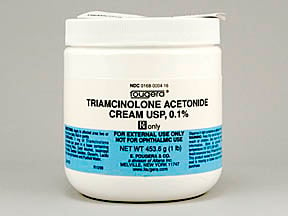
My prescription
Edit
15GM of 0.1%, Triamcinolone Acetonide (1 Jar)
Select pharmacy

CVS
$18.62
COUPON PRICE
Walmart
$1.01
COUPON PRICE
Walgreens
$4.45
COUPON PRICE
Albertsons
$5.98
COUPON PRICEFree Triamcinolone Acetonide Savings Card

Walmart
$1.01
Show this coupon to your pharmacist
ID
LHC3121A24
PCN
CHIPPO
BIN
019876
GRP
LHX
This coupon is not insurance
More prescriptions for ulcerative colitis
More prescriptions for ulcerative colitis
Price history for Kenalog-40 (brand) & Triamcinolone Acetonide (generic)
1 Jar, 15GM of 0.025%
Average retail price for Kenalog-40
Average retail price for Triamcinolone Acetonide
Average SaveHealth price for Triamcinolone Acetonide
Our price history data is based on aggregated prescription data collected from participating pharmacies in America. Our prescription data updates daily to reflect the latest price changes. If you notice a missing data point, it means there wasn't sufficient data available to generate a monetary value for that date.
We analyzed Triamcinolone Acetonide prices for (15GM of 0.025%, 1 Jar) over the last 12 months. The average retail price was $21.96, while the average price using the SaveHealth discount card was $2.93. That's a savings of approximately 86.66% when using our Triamcinolone Acetonide coupon.
Compared to the generic version, Kenalog-40 had an average price of $22.83 over the same time period. With the SaveHealth savings card, Triamcinolone Acetonide is 87.17% cheaper on average than Kenalog-40.
*Retail prices are based on pharmacy claims data, and may not be accurate when we don't have enough claims.
Triamcinolone Acetonide dosage forms
Dosage Quantity Price from Per unit 5GM of 0.1% 1 Tube $19.40 $19.40 5GM of 0.1% 2 Tubes $29.51 $14.76 5GM of 0.1% 3 Tubes $35.27 $11.76 15GM of 0.025% 1 Tube $4.83 $4.83 15GM of 0.1% 1 Tube $3.58 $3.58 15GM of 0.1% 2 Tubes $4.65 $2.33 15GM of 0.1% 3 Tubes $5.73 $1.91 15GM of 0.5% 1 Tube $6.05 $6.05 15GM of 0.5% 2 Tubes $9.60 $4.80 15GM of 0.5% 3 Tubes $13.15 $4.38
| Dosage | Quantity | Price from | Per unit |
|---|---|---|---|
| 5GM of 0.1% | 1 Tube | $19.40 | $19.40 |
| 5GM of 0.1% | 2 Tubes | $29.51 | $14.76 |
| 5GM of 0.1% | 3 Tubes | $35.27 | $11.76 |
| 15GM of 0.025% | 1 Tube | $4.83 | $4.83 |
| 15GM of 0.1% | 1 Tube | $3.58 | $3.58 |
| 15GM of 0.1% | 2 Tubes | $4.65 | $2.33 |
| 15GM of 0.1% | 3 Tubes | $5.73 | $1.91 |
| 15GM of 0.5% | 1 Tube | $6.05 | $6.05 |
| 15GM of 0.5% | 2 Tubes | $9.60 | $4.80 |
| 15GM of 0.5% | 3 Tubes | $13.15 | $4.38 |
| 15GM of 0.025% | 2 Tubes | $7.16 | $3.58 |
| 15GM of 0.025% | 3 Tubes | $9.50 | $3.17 |
Triamcinolone Acetonide Warnings
This safety information outlines essential warnings related to the use of triamcinolone. It is important to carefully review these details and consult with your healthcare provider if you have any questions or concerns.
Adrenal Gland Function: Prolonged use of topical triamcinolone over large areas of the skin can lead to reduced adrenal gland function, known as adrenal suppression. This condition occurs when the body relies on steroid medications due to insufficient production of steroid hormones. Abrupt discontinuation can result in withdrawal symptoms such as fever, joint or muscle pain, and fatigue. In children, symptoms may also include stunted growth, weight gain, and headaches. To mitigate this risk, healthcare providers will prescribe the minimum effective dose for the shortest duration. Always consult your healthcare provider before stopping the medication.
Risk Factors for Adrenal Suppression:
- Use of high-potency topical steroids
- Long-term use of triamcinolone
- Excessive application on the skin
- Covering treated areas with bandages
- Use in young children
Skin Infections: Extended use of triamcinolone may increase the risk of skin infections, including fungal or bacterial types. Avoid using triamcinolone if you have a skin infection, as it may worsen the condition. Inform your healthcare provider if you notice redness, swelling, pain, pus, or if your symptoms do not improve within a few days, as these may indicate a new infection.
Skin Problems: Overuse or prolonged use of triamcinolone can lead to various skin issues such as thinning skin, stretch marks, spider veins, burning, itching, irritation, dryness, inflamed hair follicles, skin color changes, or rash. Your healthcare provider will prescribe the lowest effective dose for the briefest period to prevent severe reactions. Report any new or worsening skin issues to your healthcare provider immediately.
By adhering to these guidelines and communicating promptly with your healthcare provider, the risks associated with triamcinolone can be effectively managed.
Triamcinolone Acetonide Side Effects
Common side effects:
- burning
- itching
- irritation
- dryness
Less common but important to monitor:
- acne
- increased hair growth
- stretch marks
- changes in skin color
- small red bumps on the skin
- inflamed hair follicles
- skin thinning
- skin infections may worsen
Serious side effects:
- unusual tiredness
- significant weight loss
- headaches
- swollen ankles or feet
- increased thirst or urination
- vision problems
- very serious allergic reaction (rash, severe dizziness, trouble breathing)
Triamcinolone Acetonide Interactions
When using triamcinolone acetonide, it's important to be aware of potential interactions with other medications, as these can affect how the drug works or increase the risk of side effects. Here are some notable interactions:
Medications Affecting Potassium Levels: Combining triamcinolone with potassium-depleting agents, such as certain diuretics or Amphotericin B, may lead to low potassium levels (hypokalemia). This can increase the risk of heart rhythm problems. Patients should be monitored closely for signs of hypokalemia.
Blood Thinners: Triamcinolone can interfere with the effectiveness of anticoagulants like Warfarin. Regular monitoring of blood clotting times is recommended to ensure proper anticoagulation.
Diabetes Medications: Corticosteroids like triamcinolone may raise blood sugar levels, potentially reducing the effectiveness of antidiabetic drugs. Adjustments to diabetes medication dosages may be necessary, and blood glucose levels should be monitored.
CYP3A4 Inhibitors: Drugs that inhibit the enzyme CYP3A4, such as Ketoconazole, certain antibiotics (like Clarithromycin), and some HIV medications (like Ritonavir), can slow the breakdown of triamcinolone in the body. This can lead to higher levels of the corticosteroid and an increased risk of side effects. Patients should be monitored for signs of excessive corticosteroid effects, and dosage adjustments may be needed.
CYP3A4 Inducers: Conversely, medications that induce CYP3A4, such as Rifampin, Phenytoin, and Carbamazepine, can speed up the metabolism of triamcinolone, potentially reducing its effectiveness. In such cases, a higher dose of triamcinolone may be required.
Vaccines: Triamcinolone may suppress the immune response to vaccines, making them less effective. It's advisable to consult with a healthcare provider before receiving any vaccinations while on corticosteroid therapy.
Grapefruit Juice: Consuming large amounts of grapefruit juice can inhibit the metabolism of triamcinolone, leading to increased drug levels and a higher risk of side effects. Patients are advised to limit or avoid grapefruit juice during treatment.
Always inform your healthcare provider about all medications, supplements, and herbal products you are taking to ensure safe and effective use of triamcinolone acetonide.
